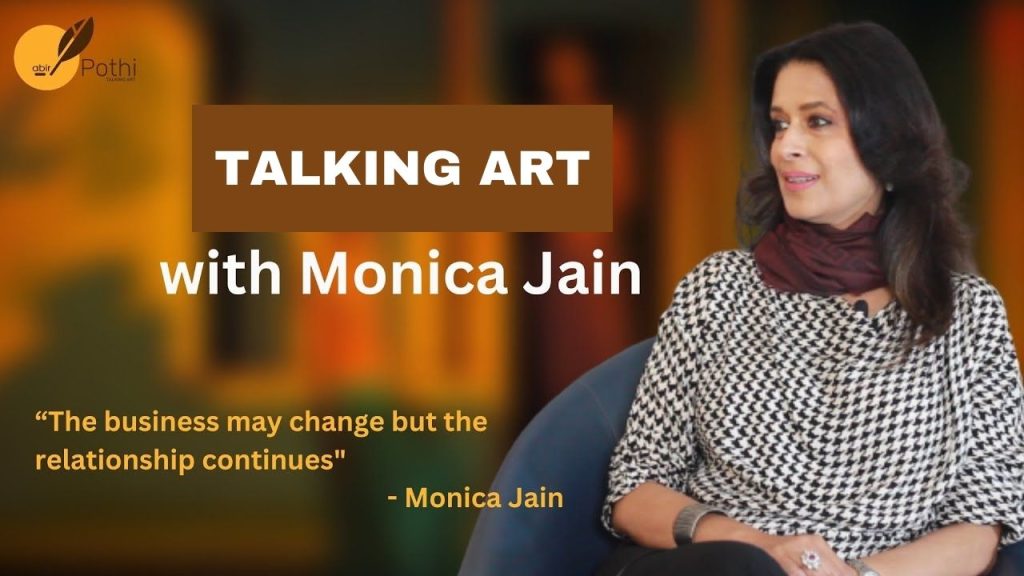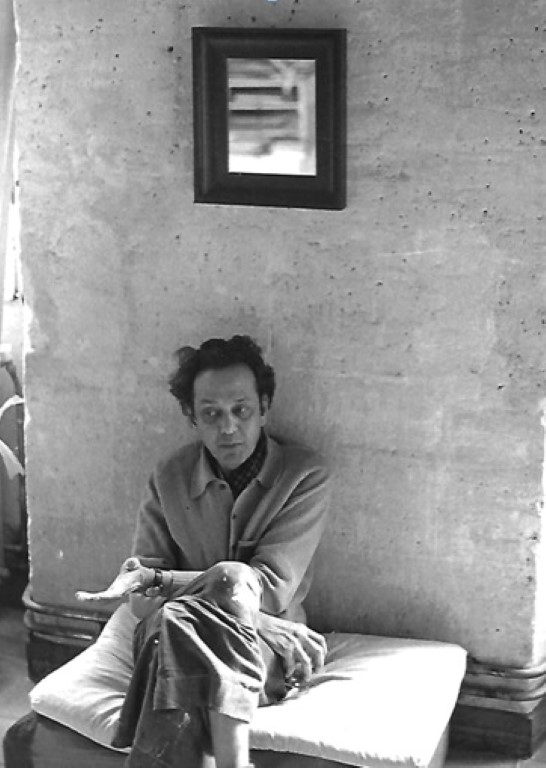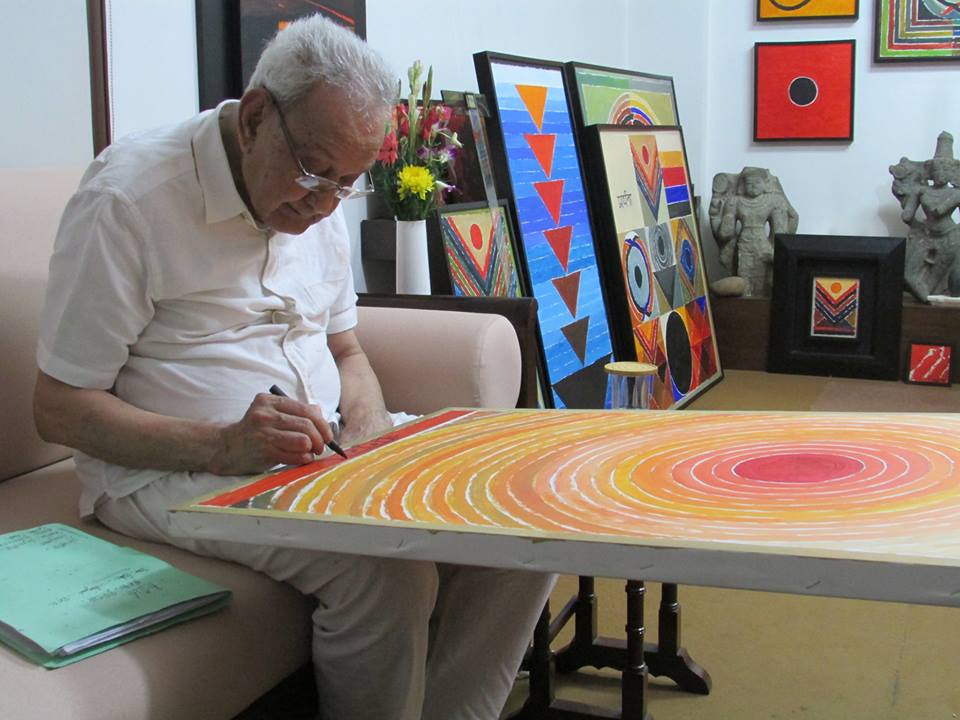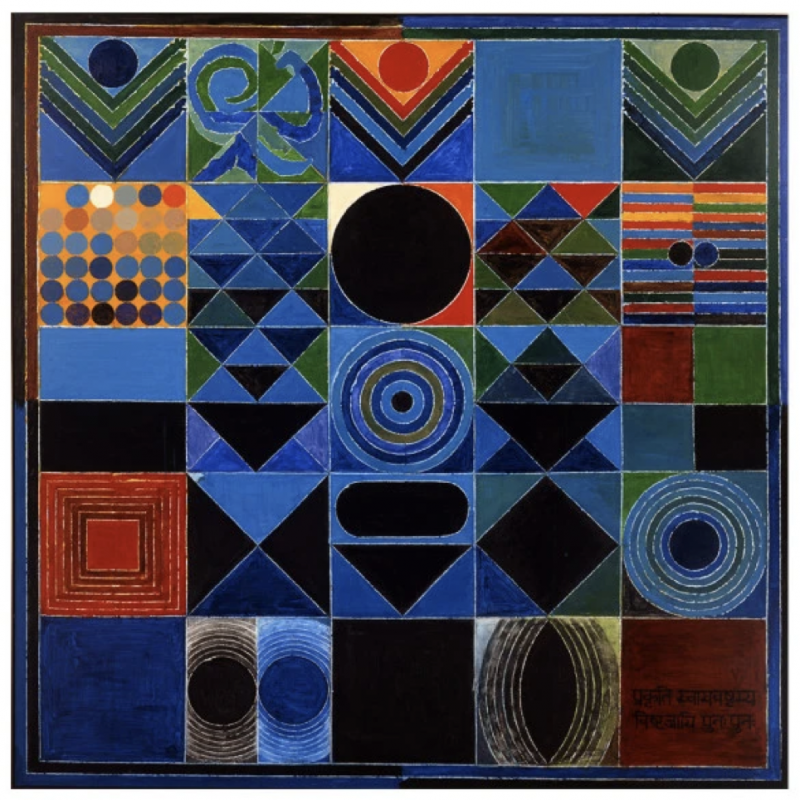Monica Jain, the Curator-Director of Art Centrix Space discusses about the art world, her way of selecting artists and why she chose contemporary art over traditional art to promote, in this free-flow interview with Abhishek Dixit from Abir Pothi. She has been a student of renowned sculptor KS Radhakrishnan and has curated more than 30 shows in the past 10 years. She has also been a patron of the Kochi Biennale Foundation since 2018.
You can see here the full video of the interview.
Abhishek Dixit: What inspired you to open a gallery which focuses on contemporary art rather than traditional art?
Monica Jain: I grew up around art and I have realised just as time, people preferences are not linear. India is one country where you have traditional art,
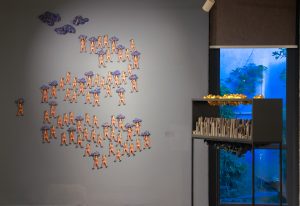
Courtesy- Art Centrix Space
contemporary art coexisting together. Looking at and judging what artists are creating today is a bigger challenge because it requires a larger understanding of art and with my experiences as a student of art in College of Art and National Museum, helped me understand what I really wanted to promote. That’s the reason I stuck to promote and work around contemporary art.
Abhishek Dixit: Now tell us about ‘Modern Fetish’ a show by Manish Sharma.
This is the on-going solo show of Manish Sharma. I have been working with him since 2017. He hails from Rajasthan originally from Bikaner and moved to Bombay for about 10 years and then came back to Jaipur. The show is about his idea of objects. As an artist, he himself is obsessed with objects. I think Rajasthan is a state which is still known for the objects, beautiful things that they produce. So I think somewhere it comes to him through that. When I visited him there, lot of the villages in Bikaner were destroyed because of plundering. Not just by the British by Indians too. In the process lot of heritage was lost and his concern was about the lost heritage and identity.
This is also very parched land. So people used to pray rain in Bikaner and in that praying they used to paint the entire walls with beautiful clowns. It was almost like if you paint them you will get rain. So the idea of ‘Modern Fetish’ came from this extreme desire for objects, commodity, which is a sort of concern today with society. We want to possess things and same thing I felt in this desire for rain. So that is how the title ‘Modern Fetish’ came.
Rahul Kumar wrote a wonderful curator essay on the show, where he interviewed Manish Sharma. So between the artist and the curatorial essay done by Rahul Kumar we were able to put together this show based on this idea of this extreme desire of something.
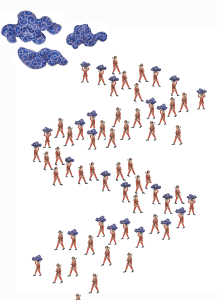
by Manish Sharma
Courtesy- Art Centrix Space
Abhishek Dixit: As you have curated numerous exhibitions throughout your career. What does it take to identify the elemental value of art and how do you evaluate that?
Monica Jain: When I started I did not want to ride on the shoulders of giants of art world. So I started with the young contemporary artists, found what is powerful in them and of course, it’s a challenge to identify the good artists. But I think my educational background empowers me with this sort of understanding. And therefore it’s been a wonderful journey to be able to talk about and to promote these young contemporary artists. I’ve been working with them for now 10 years and I think it’s a very satisfying journey.
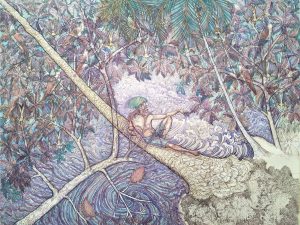
Courtesy- Art Centrix Space
Abhishek Dixit: So what kind of differences do you see between the emerging artists and the masters?
Monica Jain: Everybody start with a first. Everybody grows with life experiences, by horning your techniques, skills and thought process. So I think it’s only about the experience in the practice and the majority of reach as an artist. As you grow there are many things that life teaches you, it’s the same for any field, longer person has been there and how consistently the person has been working. One starts to value his/her advice as one gains experience.
So I think that’s about the only difference. And young artists or any artists they all have their mentors from different fields, whether it’s from art field or any others. The support structure and all community building that we have within the art world in India or anywhere else, is extremely important.
At Art Centrix Space we have a large space, I designed it for the interaction between mentors, seniors and young curators, people from different walks of life, and that really helps to build this sort community where we support each other, understand each other, and therefore disseminate the information and that way for to be consumed by people who are art lovers or would turn into art lovers.
Abhishek Dixit: Tell us something about ‘The Circle of Life’ that was curated by Alnoor Mitha.
Monica Jain: That’s an interesting show. In fact, it’s one of my biggest shows. It also took the longest, almost two and a half years to conceive it, because it was conceived just a month or two before the pandemic started.
At Art Centrix Space, we believe in building relationships with people, with artists, curators and art lover. So Alnoor Mitha has curated the solo show of Anish Kapoor. He’s worked with Imran Qureshi, he’s worked with Rashid Rana and with Pushpamalla N as well. I thought the way we talked about art, the way we wrote about art was absolutely wonderful and synced with my idea of what an art gallery should be doing and what kind of artist I should be promoting. All galleries have its own vision. So we got together because our intention was to come up with the show in 2021. And then the pandemic happened a month later. But we were fortunate to build this community. There were interactions between artists. Everyone along with senior and young contemporary artists came together on zoom calls every fortnight.
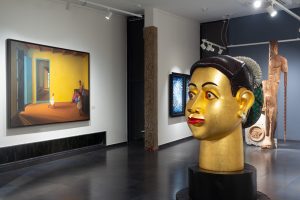
I had many veteran artists work with our gallery artists so I think all in all ‘The Circle of Life’ became a circle of connected people from different countries. Throughout the lockdown we had many interactions online staying at home and formed extremely strong bonds during that process.
I like to have this policy where the artworks get produced for the particular show. I don’t think more than 2 or 3% of the works have been taken from any other show until and unless it works for that particular show. So we worked from scratch and created some wonderful art works. The show was wonderful. The opening night that happened on November 11th, 2022 was wonderful. We were joined by Shobha Broota too. All of my younger artists were there. It was a show which brought art, the senior and the young artists together, and the interaction itself was wonderful.
Abhishek Dixit: I really liked the idea of collaborating with the young and the senior artists in presenting a show to get a wonderful take and perspective on art. What makes your gallery different from other gallery in terms of the concepts and goals you represent
Monica Jain: Because the person who heads the gallery is different and the artist roster is different, there’s bound to be a difference between all the galleries. Even when we all come together during the art fairs, we have different roster of artists. I think one of the difference, is because a lot of other gallerist are also trained in arts. My education has helped me understand art from the start, from space, from how it’s been conceived and how an artist thinks, because I’m able to put myself in their shoes. Therefore the production also happens like that. Conceptually and in terms of the vision we have.
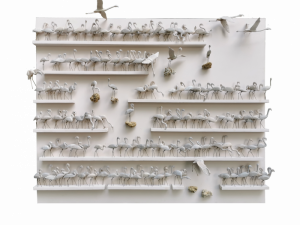
Courtesy- Art Centrix Space
I take artists from across India. There is a very dedicated program in which we’re talking about vernacular voices. We have Pinaki Ranjan Mohanty who hails from Chillika, Odisha. It’s wonderful what he does for the environment. He’s talking about migration, how the lakes are getting affected and everything related to the environment. I think that’s one voice, a very powerful voice that we are promoting. We have Bharghav Bala a photographer from Vizag. Photography is one of the most difficult mediums to promote in India. It not conceived as well as a sculpture or a painting. I have Tehmeena Firdos based out of Delhi . She has a different voice in terms of, how she talks about spaces of emotional comfort and discomfort; public and private space.
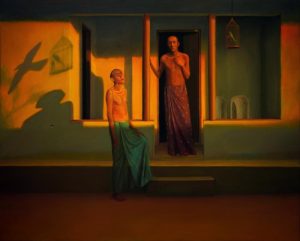
by Tom Vattakuzhy
Courtesy- Art Centrix Space
I have artist like KP Pradeep Kumar from Kerala Tom Vattakuzhy from Kerala as well. I go to every studio. I have visited each studio. Gone into the interiors of these states and had talked to them. They all follow a big vision. I think the fact that our country is so diverse, therefore the voices are diverse, and this idea of vernacular voices is extremely important for me. What Tom talks about in his works, the story behind the story, how he presents it is mesmerizing. His paintings almost, have the colours and saturations as that of Renaissance masters. But imagery and his ideas are very much his own. KP Pradeep Kumar talking about landscapes, initially it was of Kerala and later on he moved to mountains capes. His way of handling mix media on paper is quite commendable. We have a solo show coming up on October 2023. They have come from the same state but think very differently. And I think this is what fascinates me because all of us have very different perspectives, therefore, for me as a gallery to show its very perspectives is extremely important and I truly enjoy them.
Abhishek Dixit: Tell us about the major challenges that you stumbled upon during this whole journey.
Monica Jain: The challenges were always many. I started in 2012 and when I did, the people from the community told me “listen Monica you can’t be starting at this time”. Because art was at its peak in 2008 continued until 2010 and here I was starting a gallery for young contemporary artist in 2012. During those time the art world had come down, prices had come down in different fields. But I think, I personally believe that you need to support art or any other form of whatever the profession at a time when it needs the most. I didn’t think of starting a gallery because the market is already doing well.
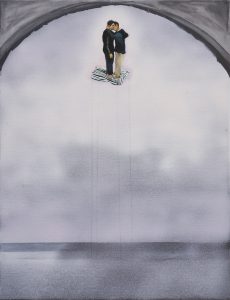
Courtesy- Art Centrix Space
Abhishek Dixit: What are the major changes that happened after the Covid.
Monica Jain: After Covid, we were lucky that art flourished. When humanity goes through challenges of life, that is when we flourish. This is the time that we start thinking what moves us most. Therefore art has always been about what comes from within us, how we think, how we feel and how we interact with the world. Because it gave us time to really think about these things some of the most powerful works emerged during this time and similarly people got time to think and enjoy at home.
During the times the artist fought and came up with newer ideas. We’ve always learned from strive. We’ve learned from our mistakes, we’ve learned from our experiences that really painted forefront and the patience and the level with which art came up and the kind of works that were created in this time was truly powerful and therefore you found people, also art lovers in procuring these works
Abhishek Dixit: As we’re talking about the process of an artist, what is your process in selecting an artwork?
Monica Jain: Like I said the most important thing is that I wanted different voices. For me building this relationship with these artists are very very important. So I think as human being for me to connect with the person is very important because that is when I understand what the artist truly wants to talk about. It also gives me sort of idea as in future what he/she is looking at. Whether we will be able to work comfortably with each other for the next 10, 20 years, because the business of art may change but the human relationships need to continue on. That is very intrinsic to Art Centrix Space. We have to have wonderful relationships with people. And in that I discover the power. That zone of comfort that I have arrived at with my artists, it helps them open up, it helps me open up with them about what I’m thinking of doing for them and with them and wonderful art emerges out of that.
Abhishek Dixit: So what would you like to suggest to the newcomers to how to approach art?
They need to know that they have to talk about their own vision. Then have the patience and have the strengths to transform it from that uncertainty to take it to that confidence that here it is, this is what I’m talking about, and be truly connected to a certain thought process of everybody in society.

